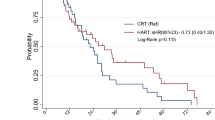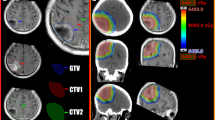Abstract
Background
Although the optimal treatment of frail glioblastoma patients is still controversial, previous randomized trials have excluded such patients. This study aimed to evaluate the feasibility and safety of hypofractionated radiotherapy (RT) with concomitant temozolomide for glioblastoma patients with poor prognostic features.
Methods
We retrospectively reviewed 33 glioblastoma patients who underwent postoperative hypofractionated chemoradiotherapy. The patient criteria were either ≥70 years or <70 years with one or more risk factors: pre-RT performance status (ECOG score) ≥3, biopsy only, or rapid disease progression immediately after surgery. The median RT dose was 45 Gy (range 30–45) with a fraction size of 3 Gy.
Results
The median age was 66.0 years. Eighteen patients (55 %) had poor pre-RT performance status (ECOG ≥3), and 16 patients (48 %) underwent stereotactic biopsy only. The median overall survival (OS) and progression-free survival were 10.6 and 7.5 months, respectively. Poor pre- and post-RT performance status [hazard ratio (HR) 3.12, 95 % confidence interval (CI) 1.21–8.07 and HR 4.51, 95 % CI 1.44–14.12, respectively] and no pseudoprogression (HR 5.43, 95 % CI 1.58–18.61) were associated with poorer OS. While acute neurologic symptoms were reported in 5 patients (15 %), toxicity profiles were acceptable without treatment-related aggravation of performance status.
Conclusions
Concurrent chemoradiotherapy with temozolomide, the current standard treatment after surgery for glioblastoma, could be shortened without increasing side effects for patients with poor prognostic features.


Similar content being viewed by others
References
Stupp R, Mason WP, van den Bent MJ et al (2005) Radiotherapy plus concomitant and adjuvant temozolomide for glioblastoma. N Engl J Med 352:987–996
Curran WJ Jr, Scott CB, Horton J et al (1993) Recursive partitioning analysis of prognostic factors in three Radiation Therapy Oncology Group malignant glioma trials. J Natl Cancer Inst 85:704–710
Mirimanoff RO, Gorlia T, Mason W et al (2006) Radiotherapy and temozolomide for newly diagnosed glioblastoma: recursive partitioning analysis of the EORTC 26981/22981-NCIC CE3 phase III randomized trial. J Clin Oncol 24:2563–2569
Roa W, Brasher PM, Bauman G et al (2004) Abbreviated course of radiation therapy in older patients with glioblastoma multiforme: a prospective randomized clinical trial. J Clin Oncol 22:1583–1588
Brandes AA, Vastola F, Basso U et al (2003) A prospective study on glioblastoma in the elderly. Cancer 97:657–662
Malmstrom A, Gronberg BH, Marosi C et al (2012) Temozolomide versus standard 6-week radiotherapy versus hypofractionated radiotherapy in patients older than 60 years with glioblastoma: the Nordic randomised, phase 3 trial. Lancet Oncol 13:916–926
Wick W, Platten M, Meisner C et al (2012) Temozolomide chemotherapy alone versus radiotherapy alone for malignant astrocytoma in the elderly: the NOA-08 randomised, phase 3 trial. Lancet Oncol 13:707–715
Perry JR, O’Callaghan CJ, Ding K et al (2012) A phase III randomized controlled trial of short-course radiotherapy with or without concomitant and adjuvant temozolomide in elderly patients with glioblastoma (NCIC CTG CE.6, EORTC 26062–22061, TROG 08.02, NCT00482677). 2012 ASCO annual meeting. American Society of Clinical Oncology (ASCO), Chicago
Gorlia T, van den Bent MJ, Hegi ME et al (2008) Nomograms for predicting survival of patients with newly diagnosed glioblastoma: prognostic factor analysis of EORTC and NCIC trial 26981-22981/CE.3. Lancet Oncol 9:29–38
Farace P, Amelio D, Ricciardi GK et al (2013) Early MRI changes in glioblastoma in the period between surgery and adjuvant therapy. J Neurooncol 111:177–185
Pirzkall A, McGue C, Saraswathy S et al (2009) Tumor regrowth between surgery and initiation of adjuvant therapy in patients with newly diagnosed glioblastoma. Neuro Oncol 11:842–852
Minniti G, De Sanctis V, Muni R et al (2008) Radiotherapy plus concomitant and adjuvant temozolomide for glioblastoma in elderly patients. J Neurooncol 88:97–103
Gerstein J, Franz K, Steinbach JP et al (2010) Postoperative radiotherapy and concomitant temozolomide for elderly patients with glioblastoma. Radiother Oncol 97:382–386
Fiorica F, Berretta M, Colosimo C et al (2010) Glioblastoma in elderly patients: safety and efficacy of adjuvant radiotherapy with concomitant temozolomide. Arch Gerontol Geriatr 51:31–35
Cao JQ, Fisher BJ, Bauman GS et al (2012) Hypofractionated radiotherapy with or without concurrent temozolomide in elderly patients with glioblastoma multiforme: a review of ten-year single institutional experience. J Neurooncol 107:395–405
Reyngold M, Lassman AB, Chan TA et al (2012) Abbreviated course of radiation therapy with concurrent temozolomide for high-grade glioma in patients of advanced age or poor functional status. J Neurooncol 110:369–374
Minniti G, Lanzetta G, Scaringi C et al (2012) Phase II study of short-course radiotherapy plus concomitant and adjuvant temozolomide in elderly patients with glioblastoma. Int J Radiat Oncol Biol Phys 83:93–99
Brandes AA, Franceschi E, Tosoni A et al (2008) MGMT promoter methylation status can predict the incidence and outcome of pseudoprogression after concomitant radiochemotherapy in newly diagnosed glioblastoma patients. J Clin Oncol 26:2192–2197
Brandsma D, Stalpers L, Taal W et al (2008) Clinical features, mechanisms, and management of pseudoprogression in malignant gliomas. Lancet Oncol 9:453–461
Chaskis C, Neyns B, Michotte A et al (2009) Pseudoprogression after radiotherapy with concurrent temozolomide for high-grade glioma: clinical observations and working recommendations. Surg Neurol 72:423–428
Reddy K, Gaspar LE, Kavanagh BD et al (2013) Prospective evaluation of health-related quality of life in patients with glioblastoma multiforme treated on a phase II trial of hypofractionated IMRT with temozolomide. J Neurooncol 114:111–116
Acknowledgments
This work was supported by the National R&D Program for Cancer Control by National Cancer Center Korea (Grant No. 1320220) and the National Research Foundation of Korea (NRF) grant funded by the Korean government (MSIP) (No. 2013M2A2A7043683).
Conflict of interest
The authors declare that they have no conflict of interest.
Author information
Authors and Affiliations
Corresponding author
About this article
Cite this article
Lim, Y.J., Kim, I.H., Han, T.J. et al. Hypofractionated chemoradiotherapy with temozolomide as a treatment option for glioblastoma patients with poor prognostic features. Int J Clin Oncol 20, 21–28 (2015). https://doi.org/10.1007/s10147-014-0690-6
Received:
Accepted:
Published:
Issue Date:
DOI: https://doi.org/10.1007/s10147-014-0690-6




